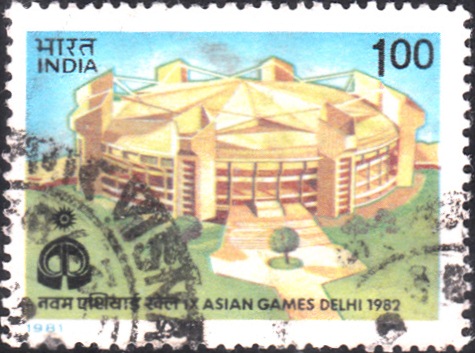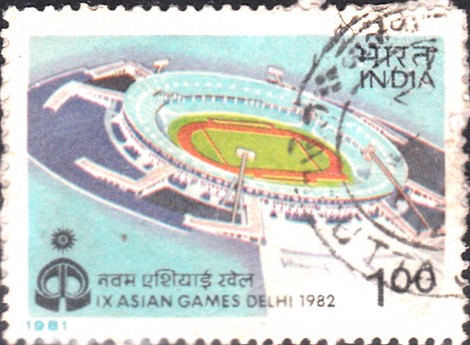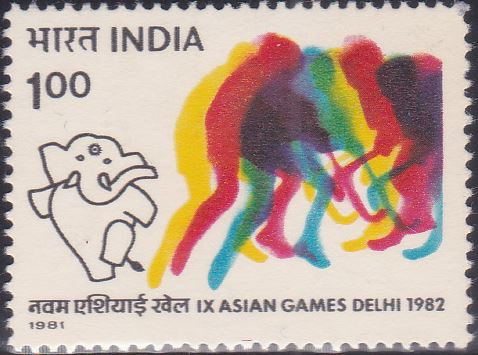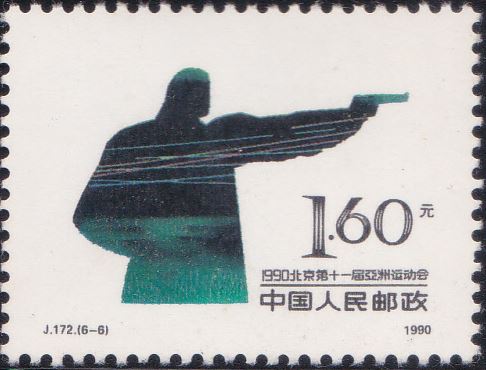
India on IX Asian Games 1982 (II)
A commemorative postage stamp on the 9th Asian Games 1982 (2nd Issue) – Indraprastha Stadium (Rajghat, New Delhi) :
 Issued by India
Issued by India
Issued on Nov 19, 1981
Issued for : Indian P & T Department is privileged to issue the second stamp on IX Asian Games.
Description of Designs : The stamp, designed by India Security Press, depicts the covered stadium at Rajghat. The design is based on photograph of the model. The First Day Cover design by Champa Lal Meena shows the National Stadium. Cancellation was designed by Charanjit Lal.
Type : Stamp, Postal Used
Colour : Multi Colour
Denomination : 100 Paise
Overall size : 3.91 x 2.90 cms.
Printing size : 3.55 x 2.54 cms.
Number per issue sheet : 35
About :
- The city of Delhi has been the vertex of social and political life of the sub-continent. Through centuries it has been fought for and defended, and often razed and pillaged. It was even deserted more than once, only to rise again like the mythical phoenix. The seat of power of many in monarch and dynasty, Delhi bears the mark of a very extraordinary history. Some speak of the seven cities of Delhi built by successive conquerors, each adding his share to the pageant. The ravages of time have laid low many a splendorous monument; yet history stands writ on the ruins that still brave the batterings of nature. The first city of Delhi, Lal Kot was raised by the Tomar Rajput King Anangpal in 11th century. The legendary hero Prithviraj Chauhan enlarged and fortified the rugged citadel with massive ramparts and renamed it Quila Raj Pithora. The soaring tower Qutab Minar built by the Slave King, Qutb–ud–din Aibak and his successor Iltutmish, still stands sentinel to the imperial battlements erected there. The other cities were built at Siri, Tughlakabad, Jahanpanah, Kotla Feroz Shah, Purana Quila and Shahjahanabad. The last of the conquerors, influenced by the living past of Delhi, raised with greatest care the new Capital, New Delhi. The density of Delhi appears to lie in being built, rebuilt and constantly built upon. The process continues today, but for a different cause. Having hosted the First Asian Games in 1951, Delhi is now getting ready for the IX Asian Games in 1982.
- The First Asian Games were held in the National Stadium which was built beyond the solemn India Gate facing the regal Rashtrapati Bhavan that crowns the Raisina Hill. The stadium is now being renovated and will be the venue of Men’s Hockey matches. The main athletic stadium is being built near the tombs of the Lodi Emperors who ruled in the 15th century. It will have a capacity of 75,000. Apart from various athletic events, this stadium will be the venue of the opening and closing ceremonies. A two-tier structure, 23 metre high, it will have an 8-lane synthetic track. The space enclosed by the tracks will be used for soccer. There will be an office area built into the stadium below the upper tier. A spacious Press Centre, equipped with world-wide telecommunications facilities, will also be located in the stadium. A computerised communication system will provide information within seconds about the events taking place in all centres. The stadium will be flood lit to suit colour TV coverage. A giant electronic score board will display the results of various events in Hindi and English simultaneously.
- An indoor stadium, being built near the samadhi of Mahatma Gandhi at Rajghat on the banks of the Yamuna, will be the venue of Badminton, Gymnastics and Volleyball. It will have a seating capacity of 25,000. The bowl like superstructure is supported by eight RCC pylons rising to a height of 44 metres. The arena can be divided into two with the help of a sound-proof collapsible partition so that two events can be held simultaneously. By the side of this stadium a Cycling Velodrome is being built according to international specifications. It will have a minimum slope of 7° rising to a maximum of 38°. The width of the track will be 7 metres and length 333.33 metres.
- Adjacent to the lush grounds of Rashtrapati Bhavan, a swimming complex is being constructed. It will have three separate pools for warming up, for the main events and for diving. A Tennis Stadium with a capacity of 1,400 and two more courts will be added to the already existing Tennis Complex having nine courts. A number of other stadia in Delhi will be used for various games. All these are being renovated and modernised. A new hall is being built in Pragati Maidan Exhibition Complex for Table Tennis and Boxing. A new shooting range of international specifications is being built at Tughlakabad, where the third city of Delhi was built by Ghiyasuddin Tughlak in 1321 A.D.
- Siri was the second city of Delhi raised by Allauddin Khilji (1296-1316). Amidst the remains of its former glory, the Asian Games Village Complex is being built to provide comfortable accommodation as well as facilities for recreation and practice for 5,000 competitors and officials who accompany them. Each of its dwelling units will have an open terrace and a private garden. The Community Hall, with a capacity of 2000, will be the venue of Weight Lifting. A special feature of the village will be the kitchen-cum-dining complex which can cater to 2000 persons at a time.
- (Text by Justus Paul)








[…] Jawaharlal Nehru Stadium, in Delhi was constructed to host 9th Asian Games in 1982. The massive facility in an all-purpose sports arena hosting football and other sporting […]